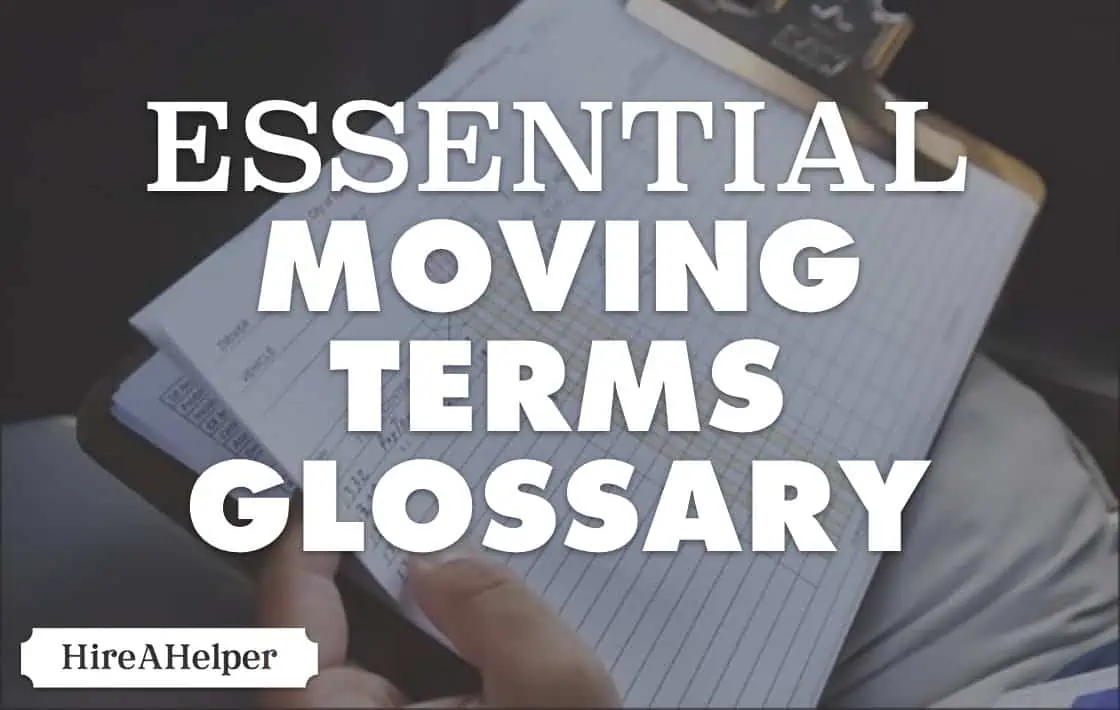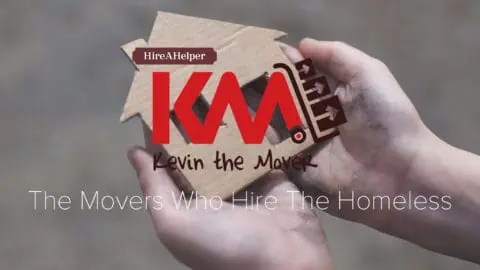Resource: A Glossary of Moving Terms, so you can Act like the Boss
Posted in: I'm a Mover, Business Basics[Synopsis: A solid understanding of our industry shows the customer we’re more than just box-movers.]
The following is a directory of super helpful terms and concepts, so bookmark this page and return to it often for help becoming even more valuable at your job – or to not be bamboozled by moving company terms!
Once upon a time when I was just getting started as a move crew member, I wasn’t concerned with things like “details of estimates”, “insurance” and “high value inventory forms”. All I cared about was packing stuff up and moving it and not damaging anything. But when customers began asking me questions about coverage and extra charges, all I could say was, “Please go ask Joe, he’s the crew leader.”
It didn’t take long for me to realize that if I could answer without having to rely on Joe, I was much happier – and so was the customer.
Even if we are only hired to load and/or unload a customer’s belongings, being able to expertly answer questions about all kinds of industry terms shows the customer that we are true professionals. This glossary is for anyone who wants to take their understanding of the moving business to the next level.
Table of Contents:
FORMS & DOCUMENTS
Order for Service:
A simple paper agreement between customer and moving company that states the customer has contracted the company to perform the move.
This document gives the moving company legal authorization to move the customer’s goods and includes the moving company’s information, the customer’s origin and destination addresses, dates for service, type of estimate, shipment valuation, charges for the agreed services and any additional service charges.
It is important to understand that an Order for Service is not a contract. An Order for Service can, in part or in whole, be amended or cancelled at any time prior to the signing of a Bill of Lading.
Bill of Lading:
A legal roundup of the agreement between customer and company. Unlike an Order for Service, a Bill of Lading is a contract for the receipt and transport of the customer’s goods.
A moving company sees this every day, but a customer is typically just told to “sign here”. It is critical that both parties understand and agree to all points, which a bill of lading helps in.
Inventory Sheets:
A list of all items the movers are moving.
The most obvious purpose for such a list is to take stock of a customer’s belongings, and to manage any damages. Generally speaking, noting any existing damages protects the moving company from liability. The importance of filling out these inventory sheets completely and accurately cannot be understated.
- Protip: Inventory sheets are not normally used on a local move, instead usually reserved for interstate moves. It is a good idea to give the customer a chance to look through the inventory sheets so they can make sure (or at least try to make sure) that all their stuff is included in those lists of boxes, pieces of furniture and everything else they own.
High Value Inventory:
A statement by the customer that there are items in their shipment that have monetary value of over $100 per pound (the standard high value threshold in the moving industry).
This often-misunderstood piece of paper is not an insurance policy. On its own, it has no legal or contractual meaning whatsoever.
The given logic behind this document is that the shipper should point out items of particularly high value to the movers so they can pay special attention to those items. If any stated items go missing or are damaged, they will be replaced at their full value, provided the shipper can produce a receipt or proof of value AND if the shipper has elected to pay for Full Valuation on their shipment.
Otherwise, if they elected the free Basic Coverage (another term we will soon discuss) they’ll still be stuck receiving a check for 60 cents for each pound of missing jewelry, gemstones and precious metals.
Estimates:
A written breakdown of the charges for all services requested by the prospective customer, to be signed and dated by both customer and moving company.
An estimate is neither a contract nor a guarantee. It is only a professional approximation of what the final cost of the move will be.
Some customers, of course, are not satisfied with ‘approximately’. So to try to make everyone happy, the moving industry has established a few different types of estimates.
- Binding Estimate: An up-front fixed cost for their move. The moving company’s sales representative considers everything specifically that will be moved, including estimated weight. This cost will not change regardless of the actual weight of the load. The advantage of a binding estimate is that the customer knows exactly what they will be paying. The downside is that the customer might end up paying a little extra if their shipment is less than estimated.
- Non-Binding Estimate: A projected final cost for a move that can change once a shipment is loaded and weighed. The actual final cost might be more or less than the estimated cost, although the customer can take comfort in the fact that moving companies cannot demand more than 110% of the non-binding estimate. There is no lower limit to the final cost, however. Therefore it makes good business sense for the moving company to be as accurate as possible in their estimates.
- Not-to-Exceed Estimate: Sometimes called a “Binding Option”, this is typically a more expensive estimate that may fluctuate, but will never exceed a certain number. It is usually offered to customers requesting a full-service move, including the packing. The advantage for the customer is that their final cost will be the lower of either the estimated cost or the actual cost; They may pay less than the estimate but they will never pay more.
Again, no estimate constitute legal agreements – that is, until they are noted on the Bill of Lading and that Bill of Lading is then signed by both customer and mover.
NOTE : Any estimate is based on services requested at the time of the estimate. If the customer later adds items or requests additional services like packing, or if temporary storage is needed before final delivery, these costs will be added to the final bill. Any honest and alert moving company representative will explain this to the customer.
VALUATION, INSURANCE & COVERAGE
We start this section by explaining two important terms: valuation and insurance. Though they are similar in some respects, they are often used interchangeably when the differences are crucial.
Valuation:
The number – in dollars – that the customer states their entire shipment is worth.
This number then becomes the limit of liability a moving company will accept for the loss and/or damage of the customer’s goods while in the moving company’s possession.
While in the moving company’s possession. This is important, because on an interstate move a customer’s goods will sometimes change hands – sometimes several times – and liability for loss or damage falls on whose hands were responsible for scratching or breaking the customer’s goods (a reminder of the importance of filling out those inventory sheets completely and accurately).
There are two types of valuation coverage:
- Full Value Coverage: Extra cost coverage that is based on the customer’s stated value of their entire shipment.
- Purchasing Full Value Coverage will usually require a minimum level of total value based on weight of the shipment. (United puts this minimum at $6.00 per pound.) Having a minimum prevents customers from purchasing full value coverage for a few hundred dollars and then claiming full value replacement for one or two items of extremely high value. Under this type of coverage the van line or mover will, for any item lost or damaged while in their possession, either repair the item, replace the item or give the customer the cash equivalent of the item. If the truck goes up in flames the moving company will be obligated to pay the customer their shipment’s stated valuation – and not a penny more.
- Basic Coverage: Low-level protection against loss or damage that the van lines will offer for free. Basic coverage is limited to 60 cents per pound of any and all items in the shipment, and that includes high value items. Most people don’t stop to think about it, but there aren’t many things worth 60 cents a pound. With this level of “protection”, the customer is hardly protected.As the old saying goes: You get what you pay for.
So what would keep a customer from saying their goods are worth ten million dollars?
Good question. Let’s address that right now as we get into the definition of insurance.
Insurance:
The coverage for a shipment through a third party provider rather than the moving company.
Terms will differ, but generally speaking insurance will offer more comprehensive protection than valuation, and often with less hassle. Insurance usually covers against “Acts of God”, offers replacement value of lost or damaged items (valuation covers only actual cash value of the item, taking depreciation into account), and remains valid through the entire move process no matter how many times the customer’s goods change hands.
- NOTE: Customers will sometimes ask their movers if their homeowners insurance covers their stuff when they move. A great answer to this would be: “It might or might not, I really can’t say. It’s best to check with your insurance company.” Seriously, the last thing we should be expected to know and give advice on is what anyone’s personal insurance policy might cover. Avoid giving any sort of opinion on the subject!
Now onto that ten million dollar valuation idea. As with any kind of insurance, the amount a customer’s belongings are covered for depends on how much they pay for their coverage. If they say they want to cover their goods for ten million dollars, they are going to pay somewhere around “a whole lot” for that coverage. The same goes for the coverage a moving company offers.
- Protip: As a matter of practice, if the customer is packing his or her own belongings, the movers will (or should) ask to see and inspect all items listed on the High Value Inventory to make sure that they are not already damaged, and that they actually exist. (Never underestimate a customer’s potential.)
- Closer to home, companies like PODS and Packrat have similar coverage policies in place. That is, they give their customers free basic coverage (offering pennies to the pound) while offering more realistic and practical coverage options for an additional fee. Customers should look into all the details to see which option best suits them. Self-storage facilities will normally offer no coverage or reimbursement for any loss or damage unless their entire facility burns to the ground and even then it’s questionable. In all cases it is best to advise the customer to speak directly with a PODS or Packrat or self-storage representative, as well as someone from their homeowner’s or renter’s insurance provider if that is a possibility.
Extra Good Stuff
Here are a few miscellaneous terms that often come up:
Accessorial Services:
Services performed in addition to the normal process of moving the customer’s goods from home to truck to home.
- Such services come at an extra charge and include things like packing and unpacking, servicing appliances, crating and un-crating, long carries between truck and home, extra flights of stairs, use of a shuttle truck when the tractor trailer cannot get close to the home, extra stops for pick-up or drop-off of goods and any other extra service requested by the customer or required by law or landlord.
Tariff (or Interstate Mover Tariff):
A lengthy and complex legal document establishing limits for how much transporters of household goods across state lines may charge the customer. These numbers are based on weight, volume and distance and also account for accessorial (extra) services that may be requested or required in the course of a household move.
All Interstate Residential Public Movers are required to publish an Interstate Mover Tariff under Federal Law and Federal Regulations before they begin operating.
SIT/Storage In Transit:
The temporary warehousing of a customer’s goods that becomes necessary in certain circumstances, usually when the customer cannot immediately move into their new home. SIT generally will not last more than 90 days; for longer periods the customer’s goods will go into regular warehouse storage.
- This is entirely different from a self-storage situation. If, for whatever reason, the customer cannot have their goods delivered to their final destination, they can – upon agreement with the moving company – have their belongings delivered to an alternate address, usually a self-storage facility. Assuming this alternative destination is close to the original destination, there should be no real change in the costs stipulated in the Bill of Lading, and this is where the contractual obligations between mover and customer will end. The customer will then have to hire another (or the same) moving service to move their goods from storage unit (or friend’s garage or wherever) to their original destination in a separate contractual situation. Or they rent a Penske and call HireAHelper.
Dunnage:
The stuff on the truck that is not part of the shipper’s goods. More specifically, it is the stuff that protects the shipper’s stuff: blankets, pads, straps and whatever other filler or covering we stick in there to prevent those scratches and dings from appearing.
- You will still hear this term from time to time. It seems to be falling out of usage, but it is worth knowing for when it does come up.
P.B.O.:
Packed By Owner. This is a detail that could mean the difference between having to pay a claim or not. Every box and carton that the customer packs him or herself should be noted as a PBO on the inventory.
Non-Allowables:
Items that movers are prohibited from putting on the truck. Some such items are obvious: gasoline, lighter fluid, charcoal, ammunition, matches, propane tanks and kerosene. Others may not be as readily-apparent: nail polish, paint thinner, car batteries, weed killer and pesticides.
- Aside from strictly prohibited items there are things that a moving company may or may not take, depending on distance and circumstances. Food and live plants are the most common of such items. And while a moving company can take a customer’s photographs, financial records and jewelry the customer is generally encouraged to take these sensitive and/or hard-to-replace items with them in their car, on the plane or however they are getting to their new home.
Consignor & Consignee:
(AKA: customer & moving company), these are terms used mainly on documents.
- To alleviate confusion, the moving company is often referred to as “the carrier”. (“No ma’am, the ‘carrier’ is the moving company…Yes, I know that Fred and I are carrying everything onto the truck but we are not the actual carriers…Yes I suppose you could call yourself a mover since you are the one who is moving…”)
We hope you found some useful tidbits of information here. If you have any questions, or have anything you would like to add, please feel free. The extra conversation helps everyone!








